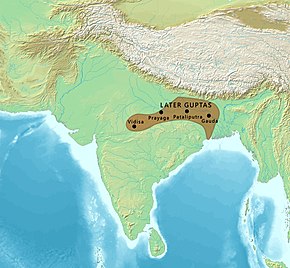Later Gupta dynasty
Later Gupta dynasty | |||||||||||||
|---|---|---|---|---|---|---|---|---|---|---|---|---|---|
| c. 490 CE–c. 750 CE | |||||||||||||
 The Later Guptas as vassals of Harsha, c. 625 CE | |||||||||||||
| Capital | Pataliputra | ||||||||||||
| Religion | Hinduism | ||||||||||||
| Government | Monarchy | ||||||||||||
| History | |||||||||||||
• Established | c. 490 CE | ||||||||||||
• Disestablished | c. 750 CE | ||||||||||||
| |||||||||||||
The Later Gupta dynasty ruled the Magadha region in eastern India between the 6th and 8th centuries CE. The Later Guptas succeeded the imperial Guptas as the rulers of Magadha, but there is no evidence connecting the two dynasties; these appear to be two distinct families.[2] The Later Guptas are so-called because the names of their rulers ended with the suffix "-gupta" (Late Brahmi: ![]() gu-pta), which they might have adopted to portray themselves as the legitimate successors of the imperial Guptas.[3]
gu-pta), which they might have adopted to portray themselves as the legitimate successors of the imperial Guptas.[3]
History
After the decline of the Gupta Empire, the Later Guptas succeeded them as the rulers of Magadha.[2] The daughter of the dynasty's founder Krishnagupta is said to have married prince Adityavarman of the Maukhari dynasty. According to the Aphsad inscription of Ādityasena, Krishnagupta's grandson Jivitagupta carried out military expeditions in the Himalayan region and southwestern Bengal.[4]
During the reign of Jivitagupta's son Kumaragupta, the dynasty developed a rivalry with the Maukharis. Kumaragupta defeated the Maukhari king Ishanavarman in 554 CE, and died at Prayaga. His son Damodaragupta suffered reverses against the Maukharis.[4]
Damodaragupta's son Mahasenagupta allied with the Pushyabhuti dynasty. His sister married the ruler Adityavardhana. He invaded Kamarupa and defeated Susthita Varman.[4] But he subsequently faced three invaders: the Maukhari king Sharvavarman, the Kamarupa king Supratishthita-varman, and the Tibetan king Songtsen. His vassal Shashanka also abandoned him (and later established the independent Gauda Kingdom). The Maukhari king Sharvavarman is thought to have defeated Damodaragupta, invading Magadha circa 575 CE, which made him ruler of the entire Uttar Pradesh.[5][6] Under these circumstances, Mahasenagupta was forced to flee Magadha, and take shelter in Malwa. Subsequently, the Pushyabhuti emperor Harsha (ruled c.606–647 CE) restored the Later Gupta rule in Magadha, and they ruled as Harsha's vassals.[2]
After Harsha's death, the Later Gupta ruler Adityasena became the sovereign ruler of a large kingdom extending from the Ganges in the north to the Chhota Nagpur in the south; and from Gomati River in the east to the Bay of Bengal in the west.[7] However, he was defeated by the Chalukyas.[8]
Jivitagupta II, the last known ruler of the dynasty, appears to have been defeated by Yashovarman of the Varman dynasty of Kannauj circa 750 CE.[7]
Rulers
The known Later Gupta rulers include:[9][10][11]

- Nrpa Shri Krishna-gupta (Kṛṣṇagupta), r. c. 490-505 CE
- Deva Shri Harsha-gupta (Harṣagupta), r. c. 505-525 CE
- Shri Jivita-gupta I, r. c. 525-550 CE
- Shri Kumara-gupta, r. c. 550-560 CE
- Shri Damodara-gupta, r. c. 560-562 CE
- Shri Mahasena-gupta, r. c. 562-601 CE
- Shri Madhava-gupta, r. c. 601-655 CE (Queen: Shrimati)
- Maharajadhiraja Aditya-sena, r. c. 655-680 CE (Queen: Konadevi)
- Maharajadhiraja Deva-gupta, r. c. 680-700 CE (Queen: Kamaladevi)
- Maharajadhiraja Vishnu-gupta (Viṣnugupta) (Queen: Ijjadevi)
- Maharajadhiraja Jivita-gupta II
Guptas of Jayapura
A small kingdom that ruled the area around Lakhisarai district during the 11th and 12th centuries bore the name Gupta and have subsequently been linked as a surviving line of the Later Gupta.[12] Evidence of their rule comes from the Panchob copper-plate inscription which was discovered in 1919.[13]
References
- ^ Schwartzberg, Joseph E. (1978). A Historical atlas of South Asia. Chicago: University of Chicago Press. p. 145, map XIV.1 (i). ISBN 0226742210.
- ^ a b c Karl J. Schmidt 2015, p. 26.
- ^ Sailendra Nath Sen 1999, p. 246.
- ^ a b c Sailendra Nath Sen 1999, p. 247.
- ^ Sinha, Bindeshwari Prasad (1977). Dynastic History of Magadha, Cir. 450-1200 A.D. Abhinav Publications. p. 119-120.
- ^ Mookerji, Radha Kumud (1 January 2016). Harsha: Calcutta University Readership Lectures 1925. Motilal Banarsidass. p. 55. ISBN 978-81-208-0862-1.
- ^ a b Sailendra Nath Sen 1999, p. 248.
- ^ Alain Daniélou 2003, p. 151.
- ^ Ronald M. Davidson 2012, p. 35.
- ^ Sailendra Nath Sen 1999, pp. 247–248.
- ^ Hans Bakker 2014, p. 83.
- ^ Chakrabarty, Dilip (2010). The Geopolitical Orbits of Ancient India: The Geographical Frames of the Ancient Indian Dynasties. Oxford University Press. p. 38. ISBN 9780199088324.
- ^ Kumar, Anil (2000). "THE PANCHOBH COPPER-PLATE OF SAMGRAMA GUPTA: A STUDY". Proceedings of the Indian History Congress. 61: 1316.
Bibliography
- Alain Daniélou (2003). A Brief History of India. Inner Traditions / Bear & Co. p. 151. ISBN 978-1-59477-794-3.
- Hans Bakker (2014). The World of the Skandapurāṇa. BRILL. ISBN 978-90-04-27714-4.
- Karl J. Schmidt (2015). An Atlas and Survey of South Asian History. Routledge. ISBN 9781317476818.
- Ronald M. Davidson (2012). Indian Esoteric Buddhism: A Social History of the Tantric Movement. Columbia University Press. ISBN 9780231501026.
- Sailendra Nath Sen (1999). Ancient Indian History and Civilization. New Age. ISBN 9788122411980.

